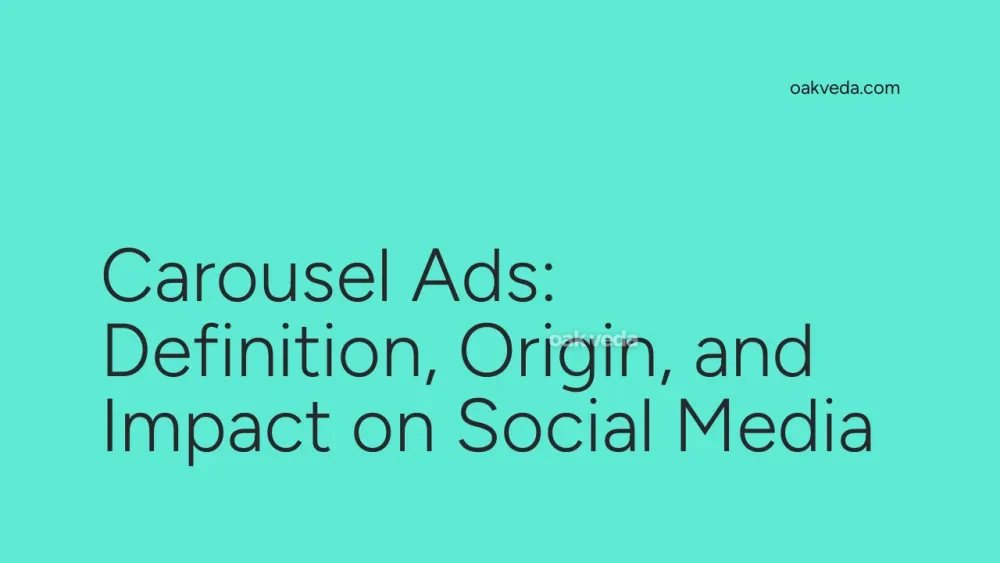
What are Carousel Ads?
Carousel ads are an innovative and interactive advertising format used across various social media platforms. These ads allow advertisers to showcase multiple images or videos within a single ad unit, creating a swipeable or scrollable content experience for viewers. Each carousel typically contains 3-10 cards, with each card featuring a distinct image or video, accompanied by a headline, descriptive text, and a call-to-action (CTA) button.
Origin and Development of Carousel Ads
Carousel ads first gained prominence when Facebook introduced them in 2014. Initially designed for mobile devices, these ads quickly proved their effectiveness and were soon adapted for desktop use. Following Facebook's success, other major social media platforms like Instagram, LinkedIn, Twitter, and Pinterest incorporated carousel ads into their advertising offerings.
The evolution of carousel ads has been driven by the increasing demand for more engaging and interactive content in the digital advertising space. As user attention spans shortened and competition for eyeballs intensified, advertisers needed a format that could tell a more comprehensive story and showcase multiple products or features within a single ad unit.
How Carousel Ads Work
Carousel ads function by presenting a series of cards that users can swipe through horizontally on mobile devices or click through on desktop platforms. Each card acts as a mini-advertisement, allowing brands to:
- Tell a sequential story
- Highlight multiple products or features
- Explain a complex process step-by-step
- Showcase different aspects of a single product
The interactive nature of carousel ads encourages user engagement, as viewers actively participate in exploring the content. This increased interaction can lead to higher click-through rates and improved ad performance compared to static single-image ads.
Types of Carousel Ads
While the basic structure of carousel ads remains consistent across platforms, there are several variations:
- Image Carousels: The most common type, featuring a series of static images.
- Video Carousels: Incorporate short video clips instead of or alongside static images.
- Mixed Media Carousels: Combine both images and videos in a single ad unit.
- Collection Ads: A variation that pairs a main image or video with a carousel of related products.
Popular Examples of Carousel Ads
Many brands have successfully leveraged carousel ads to create engaging campaigns:
- IKEA: Used carousel ads to showcase different room setups, allowing users to swipe through various interior design ideas.
- Netflix: Promoted new series by featuring different characters or scenes in each card of the carousel.
- Airbnb: Highlighted multiple vacation rentals in a single ad, showcasing the variety of options available to travelers.
- BMW: Created a storytelling experience by using each card to reveal a different feature of a new car model.
Impact of Carousel Ads on Social Media Culture
Carousel ads have significantly influenced social media advertising and user behavior:
- Increased Engagement: The interactive nature of carousels encourages users to spend more time with ads, leading to higher engagement rates.
- Storytelling Opportunities: Brands can craft more complex narratives, leading to more creative and compelling ad content.
- Product Discovery: Users can explore multiple products or features without leaving their social media feed, enhancing the shopping experience.
- Data-Driven Optimization: Advertisers can analyze which cards perform best, allowing for continuous improvement of ad content.
How Brands and Influencers Use Carousel Ads
Brands and influencers leverage carousel ads in various ways:
- Product Catalogs: Showcasing multiple products from a collection or line.
- Before and After: Demonstrating transformations or results over time.
- Tutorials: Providing step-by-step guides or recipes.
- Event Promotion: Highlighting different aspects of upcoming events or conferences.
- Customer Testimonials: Featuring multiple customer reviews or case studies.
Influencers often use carousel ads to showcase sponsored products, provide behind-the-scenes content, or offer multi-part tips and advice to their followers.
Future Trends Related to Carousel Ads
As social media advertising continues to evolve, several trends are shaping the future of carousel ads:
- AI-Powered Personalization: Using artificial intelligence to dynamically adjust carousel content based on user preferences and behavior.
- Augmented Reality Integration: Incorporating AR features to allow users to virtually try products directly within the carousel.
- Shoppable Carousels: Enhancing e-commerce capabilities by allowing direct purchases from within the ad unit.
- Interactive Elements: Adding polls, quizzes, or mini-games to further increase engagement.
- Video-Centric Carousels: Shifting focus towards more video content as bandwidth and mobile capabilities improve.
FAQs about Carousel Ads
-
How many cards can a carousel ad have? Most platforms allow between 3-10 cards per carousel ad.
-
Are carousel ads more expensive than single-image ads? Pricing varies by platform, but carousel ads often offer better value due to their higher engagement rates.
-
Can carousel ads be used for lead generation? Yes, many platforms allow you to include lead generation forms within carousel ads.
-
Do carousel ads work on all devices? Carousel ads are designed to be responsive and work on both mobile and desktop devices.
-
How can I measure the success of my carousel ad? Key metrics include engagement rate, click-through rate, conversion rate, and individual card performance.
Carousel ads have revolutionized social media advertising by offering a more interactive and engaging format for brands to connect with their audience. As technology advances and user preferences evolve, carousel ads are likely to remain a crucial tool in the digital marketer's arsenal, continually adapting to meet the changing landscape of social media advertising.
You may be interested in:
- Vlogging: Definition, Origin, and Impact on Social Media
- DM (Direct Message): Definition, Origin, and Impact
- Binge-Watching: Definition, Origin, and Impact on Social Media
- Chatbot: Definition, Origin, and Impact on Social Media
- Crispy R: Definition, Origin, and Impact on Social Media
- Quiet Quitting: Definition, Origin, and Impact

